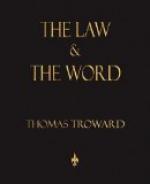For instance, if I show an artist a picture, and he tells me that a boat in it is half a mile away from the spectators, I may accept this on his authority, because I suppose he knows all about it. But if next day a friend shows me a picture of a bit of coast with a fishing-boat in the distance, and asks me how far off that boat is, I am utterly stumped because I do not know how the artist was able to judge the distance. But if I understand the principle, I give my friend a very fair approximation of the distance of the boat. I work it out like this. I say:—the immediate foreground of the picture shows an amount of detail which could not be seen more than twenty yards away, and the average size of such details in nature shows that the bottom edge of the picture must measure about ten yards across. Then from experience I know that the average length of craft of the particular rigging in the picture is, say, about eighty feet, and I then measure that this length goes sixteen and a half times across the picture on the level where the boat is situated, and so I know that a line across the picture at this level measures 80 x 16-1/2 = 1320 ft. = 440 yards. Then I make the calculation: 10 yds.: 440 yds.:: 20 yds.: the distance required to be ascertained 440 x 20 / 10 = 880 yds. 1760 yds. = 1 mile and 1760 / 2 = 880 yds. Therefore I know that the boat in the picture is represented as being about half a mile from the spectator. I really know the distance and do not merely guess it, and I know how I know it. I know it simply from the geometrical principle that with a given angle at the apex of a triangle the length of a perpendicular dropped from the apex to the base of the triangle will always bear the same ratio to the length of the base, whatever the size of the triangle may be. In this way I know the distance of the boat in the picture by combining mathematics and my own observation of facts—once again to co-operation of Law and Personality. Now a familiar instance like this shows the difference between being told a thing and really knowing it, and it is by an analogous method that we have now arrived at the conclusion that the Perfect Word is a combination of the Human and the Divine. We have definite reasons for seeing this as the ultimate fact of human development—the power to give expression to the Perfect Word—, and that this follows naturally from the fact of our own existence and that of some originating source from which we derive it.
But perhaps the reader will say: How can a Word take form as a Person? Well, words which do not eventually take form as facts only evaporate into thin air, and we cannot conceive the Divine Ideals of Man doing this. Therefore the expression of the Perfect Word on the plane of Humanity must take substance in the Form of Humanity. It is not the manifestation of any limited personality with all his or her idiosyncrasies, but the manifestation of the basic principle of Humanity itself common to us all.




